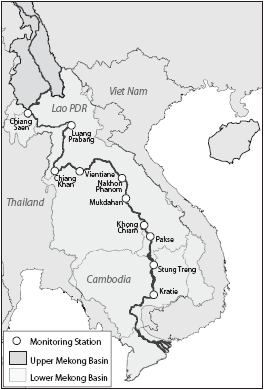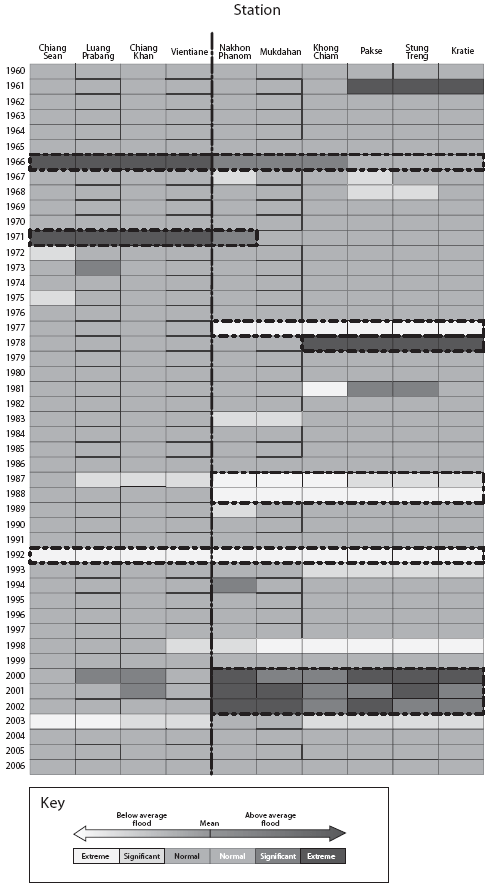Floods and the Mekong River system (Part 3)
By Tim Burnhill and Peter Adamson*
In this final article in our three-part series, we examine the magnitude of flooding in the Lower Mekong Basin and whether extreme floods are becoming more common
Figure 1. Hydro-meteorological
stations
Location of stations on the mainstream of the
Mekong with good and lengthy historical records
In the second article in this series (Catch and Culture 14(1)) we described how hydrologists measure the size of the annual flood according to its volume (annual flood volume) and its height (annual flood peak). Using the historical record of these two criteria, they are able to categorise the size of floods into normal, significant and extreme, by reference to the average annual flood volume and the average annual flood peak.1 In addition to these measures, hydrologists also use the 'long-term mean annual discharge'2 to define the onset and end of the wet season. Put simply, the wet season begins when the flow of the river exceeds the longterm mean annual discharge, and ends when the flow drops below this value.
These four measurements-annual flood volume, annual flood peak, onset of the wet season, and end of the wet season-can be calculated using records from hydro-meteorological monitoring stations along the Mekong from Chiang Saen in northern Thailand to Tan Chao on the Mekong Delta of Viet Nam (see Figure 1). The records from many of the stations extend back decades (for example, those from the station at Vientiane go back to 1913) and together they provide a unique data set with which to evaluate variations in the onset of the seasons and the magnitude of the flood, both across the basin and through time.
The onset of the seasons
For most of the people living in the Lower Mekong Basin (LMB),
early to mid November is a special time; the monsoon has withdrawn,
the harvest is in, and fresh new rice is on the table. It is
a month of festivals-Bone Omtouk in Cambodia, That
Luang in Lao PDR, in Loy Kha Tong in Thailand.
Table 1. Wet seasons
Start and end of the wet season at Vientiane and Kratie
| Week of occurrence | ||||
| Vientiane | Kratie | |||
| Average Week No. (date) |
Standard Deviation (weeks) |
Average Week No. (date) |
Standard Deviation (weeks) |
|
Start wet season |
25 (23rd June) |
22 | 25 (23rd June) |
1.9 |
End wet season |
45 (11th November) |
2.1 | 44 (7th November) |
1.7 |
The dates of these festivals are set to coincide with the first full moon in November, and therefore the actual calendar dates vary slightly from year to year. The fact that the dates of these festivals (and others that celebrate the changing seasons) can be determined with such confidence is due to the surprising reliability of the annual hydrograph of the Mekong river system. Table 1 above gives the average week and date of the start and end of the flood season at Vientiane and Kratie, based on records extending back to 1913 and 1924 respectively. Two features stand out. Firstly, these average dates are almost identical at both locations. Secondly, the date when the flood season starts and ends is very predictable-the standard deviation of each event is only about two weeks.
Figure 2. Typhoons and
storms
Frequency of typhoons and tropical storms in the Lower Mekong
Basin.
The arrow indicates that the landfall of typhoons and storms
coming from
the South China Sea move from north to south Viet Nam as the
wet
season progress.

The similarity of the timing of the onset of the seasons at Vientiane and Kratie is surprising as the contribution to the overall flow of the Mekong from Upper Mekong Basin in China (the Yunnan component) is far greater at Vientiane than Kratie.3 Furthermore, the flow at Kratie is strongly influenced by the contribution from the so-called 'left bank tributaries', such as the Se Kong, Se San, and Sre Pok. These tributaries drain catchments that receive large amounts of rainfall from typhoons and tropical storms that develop over the South China Sea, and track across the southern part of the LMB during the latter part of the monsoon season (Figure 2).
Given these factors, it might be expected that the flood season would begin earlier in Vientiane and end later in Kratie. That this is not the case, illustrates the dominant imprint of the SW Monsoon on the overall climatic pattern of the region and the hydrology of the Lower Mekong Basin.
The regularity of the dates on which the flood season starts and ends is one of the most striking features of the hydrology of the basin. They are far more predictable than are either the volume of the annual flood or the height of the annual flood peak. This predictability is very important for the animals and plants that have evolved to take advantage of the benefits that come with the cycle of flood and recession. The life cycles of many are adapted to be in step with the pace of changing of the seasons. Therefore, its is likely that modifications to the timing of the flood caused by humans on a global (climate change) or a regional (development of water resources) scale, will effect the animal and plant life of the Lower Mekong Basin on which many of the people of the basin depend for their livelihoods.
Figure 3. Signifi cant and extreme flood
years
Historic and geographic distribution of significant and extreme
flood years in the
Lower Mekong Basin
The magnitude of the flood
While the timing of the start and end of the flood is remarkably
consistent, the magnitude of the flood, particularly the annual
flood volume, has varied at different localities in the basin.
This means that one part of the basin can suffer a significant,
or even an extreme, flood year while at the same time other
parts have a normal flood year. This year, 2008, provides a
good example of this geographical disparity (see box above).
Figure 3 illustrates the historical record of the flood of ten hydro-meteorological monitoring stations on the mainstream of the Mekong, classified according to the magnitude of the annual flood volume (see Figure 1 for location). The plot of these records, both geographically and through time, gives an excellent visual image of the variability of the flood.
One striking observation is the discontinuity between the stations upstream and downstream of Vientiane. In 1966, for example, the extreme flooding suffered by the stations upstream diminished rapidly downstream, such that Pakse recorded a normal flood year. The flood in 1971 followed a similar pattern. In contrast, the significant and extreme floods from 2000 through to 2002 were confined to the downstream stations. During the same period, the stations upstream of Vientiane recorded normal flood years. Years when the flood was significantly below normal are largely restricted to downstream stations. So, while the floods in 1977, 1987, and 1988, were extremely low downstream of Vientiane, they were normal upstream of the city.
This geographical discontinuity in the flood records reflects an important characteristic of the climate of the Lower Mekong Basin and the hydrology of its river system. It appears that while the SW Monsoon is the dominant weather system defining the overall character of the wet season (such as its duration), it is typhoons and tropical storms that are largely responsible for the extremes. Unlike the monsoon, which brings moist air from the Indian Ocean to the west, these originate in the east over the Pacific Ocean, and make landfall along the coasts of southern China and Viet Nam.
In most years, the landfall of these storms moves southwards as the typhoon season progresses (MRC, 2008). As a result, the early typhoons shed most of their rain in catchments outside the Lower Mekong Basin, such as the Red River Basin in northern Viet Nam. However, occasionally, intense storms early in the season, such as typhoon Phyllis in 1966 and tropical storm Kammuri this year (2008), have the strength to track over northern Lao PDR, causing extreme flooding upstream of Vientiane.
Later in the typhoon season, the storms make landfall on the narrow costal plain of central and southern Viet Nam before tracking across the highlands that form the border with Lao PDR (see Figure 2 on page 27). Rain that falls on these mountains feeds the catchments of the large left bank tributaries of the Mekong, which enter the river downstream of Vientiane. In the wet season these catchments contribute well over 50% of the discharge of the Mekong, and exert great influence on the volume of water entering the highly productive floodplains of the Great Lake-Tonle Sap system and the Mekong Delta.
'Typhoons and tropical storms are largely responsible for the extremes'
Only rarely have extreme flood years (either high or low) been recorded basin-wide. In the case of low years, these tend to be those wet seasons, such as in 1992 and 2003, when the monsoon is weak, or fails, and the flood throughout the basin is well below normal.
Are extreme floods becoming more common?
In extreme years it is natural enough to look for external causal
factors, such as climate change or perhaps dams on the mainstream,
rather than accepting these years as falling within the envelope
the Mekong's natural flow. However, looking at the distribution
of these extreme flood years within the natural envelope may
be more informative. Do they form clusters? Are they becoming
more common? A cursory look shows little pattern to records
of the sites upstream of Vientiane. On the other hand, the records
of the downstream locations do show some pattern-e.g. dry years
in 1987 - 88, wet years in 2000 - 03. Furthermore, extreme flood
years seem to have been more common after 1986. (For example,
9 of the 13 significant or extreme flood years recorded at Kratie
occurred in the 20 years since 1987, while only 4 were recorded
in the previous 27 years).
The flood in 2008
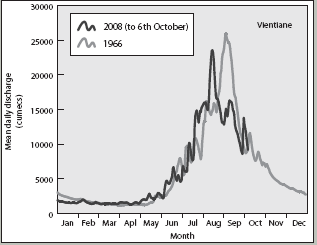
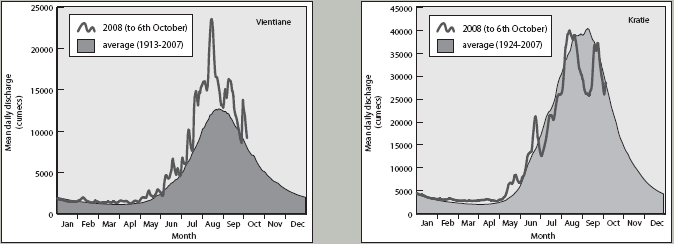
It is too early yet to know if these patterns are the response to human activity or are features of other natural phenomena. Hydrologists define the 'natural envelope' using only the hydrological records that are available to them. While these may go back a few decades, they represent only a small window in the overall history and prehistory of the Mekong. It is more than likely that the flow of Mekong is cyclical at a number of time scales, ranging from decades, through millennia, to millions of years, and that these cycles are responses to a variety of earth orbital and solar factors that drive climate change.4 Therefore, caution is required before attributing these apparently recent changes to modern anthropogenic causes.
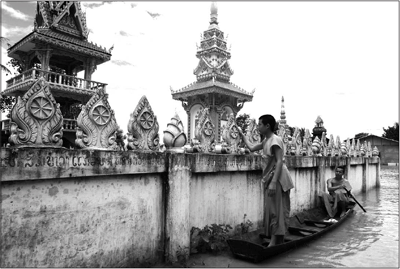
Lao monks surveying flood damage at
a Vientiane temple in August,
2008
Photo: Stanisl as Fradelizi
Nevertheless, the influence of human induced climate change and the impacts of resource developments cannot be denied. The glaciers on the high Himalaya are retreating (WWF, 2005), sea levels will rise, and the water resources of the Mekong will be exploited. These factors will inevitably modify the flow of the river and its seasonable variability, and will have both predictable and unforeseen consequences on the river flow, its ecosystems, and for the people whose livelihoods and lives depend on them.
Understanding the floods of the Mekong in their both recent and their historic and prehistoric contexts, may just provide a guide to the nature of extreme floods in the future.
*Dr Burnhill is a science writer with the MRC and Dr Adamson is a hydrologist providing services to the MRC.
References
Kale, V.S., Gupta, A. and A.K. Singhvi (2003). Late Pleistocene - Holocene palaeohydrology of monsoon Asia. Palaeohydrology: Understanding global change. Eds K.J. Gregory and G. Benito. John Willey & Sons. Ltd. London. pp 213 - 232.
MRC (2005) An overview of the hydrology of the Mekong Basin. Mekong River Commission, Vientiane, Lao PDR.
MRC (2008) Flood situation report, August 2008. MRC Technical Paper No 21. Mekong River Commission, Vientiane, Lao PDR.
Wang, P. et al. (2005) Evolution and variability of the Asian monsoon system: state of the art and outstanding issues. Quaternary Science Reviews. 24(2005). pp 595-629.
WWF (2005) An overview of glaciers, glacier retreat, and subsequent impacts in Nepal, India and China. World Wildlife Foundation, Nepal.
___________________
1 A significant flood year is defined as a year
when either the annual flood volume or the annual flood peak
is greater than one standard deviation greater or less than
the average value. In an extreme flood year these values exceed
two standard deviations greater or less than the average mean.
Of course, it is possible to have significant wet and significant
dry flood years, and extreme wet and extreme dry flood years.
2 The mean annual discharge is the average discharge (flow) of the river over a whole calendar year. The long-term mean annual discharge is the average of this value over the period of record.
3 In the wet season, contribution of the Yunnan component to the flow of the Mekong is about 40% at Vientiane and less than 15% at Kratie (MRC, 2005). In the dry season this contribution increases to about 60% and 30% respectively.
4 Comprehensive accounts of the variety of external factors that affect the evolution and variability of the monsoon can be found in Kale et al. (2003) and Wang et al. (2005). These factors include plate tectonic activity (millions of years), earth orbital dynamics—including glaciations (100,000 to 10,000 year cycles), solar activity (1,000 to 10 year cycles), and El Niño and La Niña oscillations (8-3 year cycles).
Choose a newsletter:
